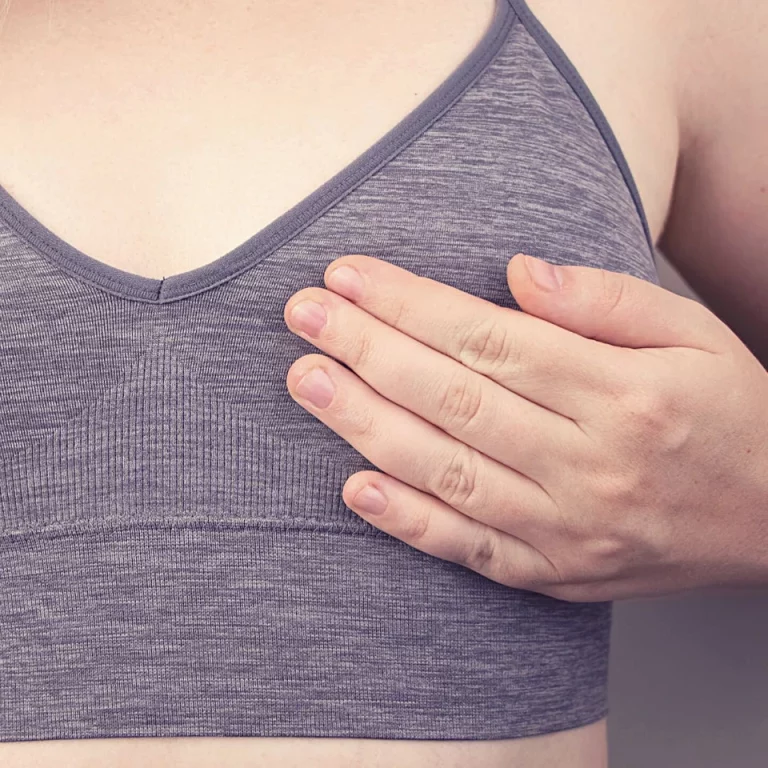What causes breast pain?
The real answer is . . . We don’t know. But we do know there’s a 99% chance it’s NOT cancer (Kushwaha et al.).
Breast pain is extremely common and as many as 70% of women will experience it at some point in their lifetime (Kataria et al.). Sometimes it is a dull ache, like increased heaviness and sensitivity that corresponds with the menstrual cycle. Sometimes it’s in both breasts, sometimes only one. Pain which fluctuates with the cycle is called “cyclical pain”. What scares women is when it’s a sudden, sharp pain in one area in one breast. That is referred to as “focal pain”. Focal pain is more likely than cyclical pain in women in their 40s and 50s.
In multiple studies conducted among women with focal breast pain and no other symptoms, 1% were found to have breast cancer. Breast cancer is far more likely to present with an abnormal finding on a mammogram or a lump in the breast, Regardless, we ALWAYS double check with imaging tests.
The best test is an ultrasound to check the area(s) of pain and sometimes a mammogram as well. Occasionally the ultrasound will show a cyst in the area which is causing the pain, but most of the time, there’s nothing there.most commonly what’s seen is normal, healthy breast tissue and nothing which looks abnormal on the imaging tests.

“So what’s causing my pain then, Doc? Can you fix it??” is the conversation which starts as soon as I tell someone we didn’t find any cause for the pain.
The truth is hormonal changes in the breast are complicated and we don’t know the exact cause or the best treatment for breast pain. There are ongoing studies and theories, but we are still working on understanding the interactions between breast tissue and the rest of the body. Additionally there are other disorders which can cause referred breast pain, such as inflammation of the cartilage of the ribs.
Even if the cause or an easy fix for breast pain has not been identified, there are treatment options available. Studies have shown that over 70% of women wear improperly fitting bras and switching to a more supportive bra or a sports bra will help. Non steroidal anti-inflammatories like Ibuprofen have also been shown to be effective in 80% of women (Kataria et al). For focal pain, there is a topical version of Ibuprofen which works better than other treatments. Relaxation techniques such as meditation and acupuncture which work for other forms of pain may also help.
But as you probably noticed, none of these are treatments designed to treat only breast pain specifically. Studies on breast specific pills such as evening primrose oil and danazol have not had convincing enough results to recommend them for everyone. Additionally, they can have serious side effects such as diarrhea or facial hair growth.
Most of the time breast pain goes away on its own, especially as we get older and our breast tissue becomes less active. Studies have shown that non cyclical breast pain may resolve on its own in up to 50% of patients (Kataria et al.). If not, changing bras and/or taking Ibuprofen may help. If none of the above works, there are other medications which are worth trying. Before taking anything, please discuss the risks and benefits with your doctor and decide on a plan that works for you.
After reading this if you develop breast pain, what should you do?
If it’s new and doesn’t go away in a day or two, see your primary care doctor or Ob Gyn. Make sure your care plan includes an ultrasound and/or mammogram and not just a physical exam. If your doctor doesn’t order an imaging test – don’t be afraid to ask about it. Your care plan is always something you should fully understand. If you’re worried about insurance coverage, new breast pain is a clear indication for an imaging test, even if you’ve had a normal mammogram recently. You should not have to pay out of pocket, provided your insurance covers imaging studies at baseline.
Once you get the ultrasound +/- mammogram, be prepared for the results. Most of the time there won’t be a cause for your pain and sometimes that’s hard to hear. The most important thing is that cancer has been ruled out.
Even if we don’t know the cause we do have treatment options. You will expand on your care plan with your doctor – you do not have to keep living with breast pain! In most situations, one of the above mentioned treatments works well, or in some women, the pain gets better on its own. It may take some trial and error to figure out the best combination of therapies for your pain. Rest assured, you will not need another doctor’s visit or repeat imaging.
Related: 8 Scientific Breastfeeding Benefits
However, if the pain is persistent despite treatment or you develop new breast pain, have it checked out. Don’t assume it’s nothing because you’ve had negative imaging tests recently. You should feel empowered to consult your physician with ANY new breast symptoms, not just breast pain.
And of course, if you’re over 40 or have a strong family history, make sure you get yearly mammograms and take control of your breast health!
Author:
Dr. Amani Jambhekar MD
Board Certified in General Surgery
Fellowship Trained in Breast Surgical Oncology
Sources:
Kataria, et al. “A Systematic Review of Current Understanding and Management of Mastalgia.” Indian J Surg. 2014 Jun; 76(3): 217–222.
https://www.ncbi.nlm.nih.gov/pmc/articles/PMC4141056/
https://www.ncbi.nlm.nih.gov/pmc/articles/PMC4960349/
https://www.ajronline.org/doi/full/10.2214/AJR.17.18879
We discuss products we think are useful to people. If you buy something through our links, we may earn a commission. Remember to check with your personal physician to see if a product recommended is right for you.








